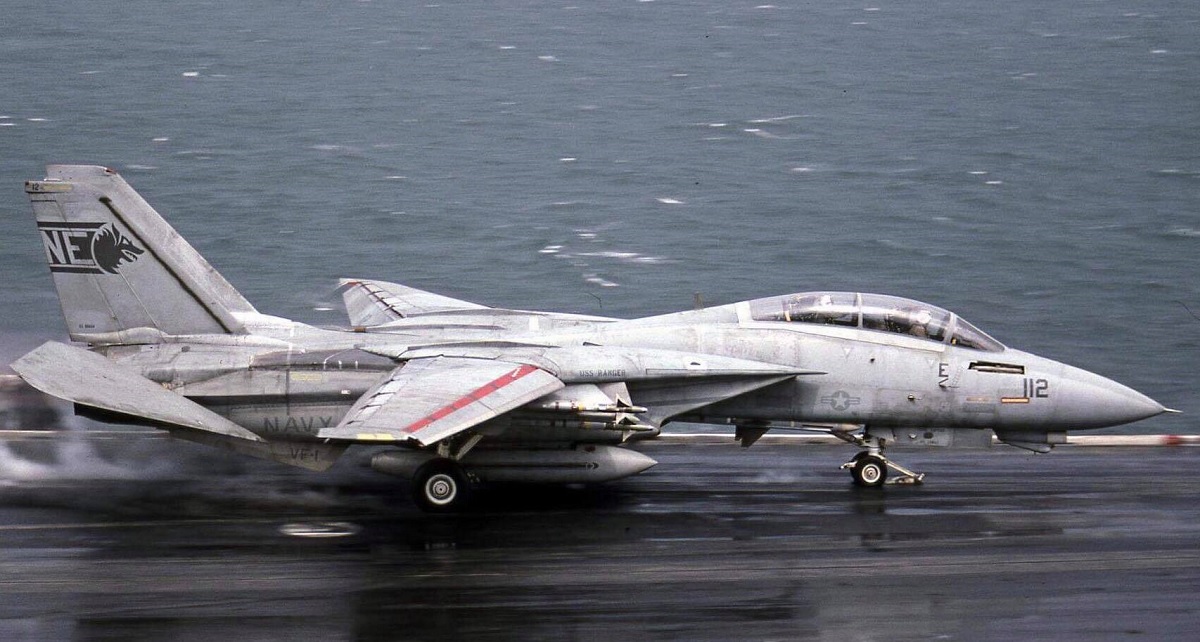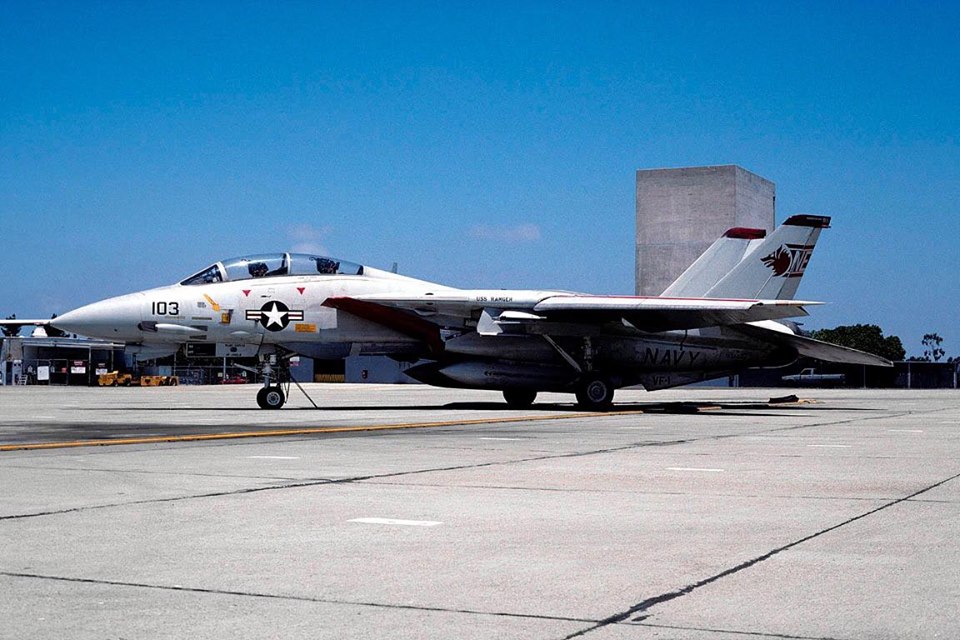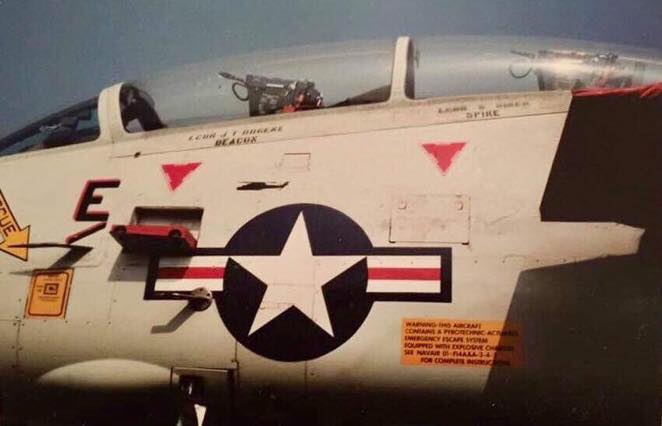Stenciled on the tails of VF-1’s Wichita 103 were the words “El Coyote”. This Tomcat scored the first recorded air-to-air kill against an Iraqi helicopter in Desert Storm.
After a four-day port call at Subic Bay in the Philippines, the USS Ranger set sail on Jan. 3, 1991, for the Persian Gulf, arriving on Jan. 15. The men and women of carrier air wing two (CVW-2) were ready for combat when called upon by their country. In the early morning hours of Jan. 17, Ranger’s air wing participated in the first airstrikes of Operation Desert Storm. VAW-116 E-2C Hawkeyes ranged all the way up the Persian Gulf to keep track of all aircraft in the vicinity. Iraq’s actions the previous decade with its Mirage F.1EQs armed with Exocet anti-ship missiles gave USN planners serious concern. The Iraqi Exocet missiles had achieved success against Iranian ships and the USS Stark, so combat air patrols (CAPs) of USN F-14 Tomcats were placed in the Persian Gulf and Red Sea to deter any threats coming out over the water.
LT Stuart “Meat” Broce from VF-1 “Wolfpack” on the USS Ranger was involved in these CAPs the first night of the war. Stu recollects, “Some (F-14s) went along on strikes in Kuwait. I got to CAP over the gulf to ‘de-louse’ the strike packages heading south. Lots of radar contacts, but all were just returning strike aircraft, some with IFF forgotten in the excitement. Joining up on supersonic targets at night to VID turned out to be impractical. We were actually laughing at the futility.” This trend would continue for the majority of the war and their only opportunity to perform this mission would be denied. On Jan. 24, a pair of Iraqi Mirage F.1EQ-4s that were streaking into the Persian Gulf wasn’t downed by Tomcats but by a Saudi F-15C Eagle that shot down both intruders with AIM-9P Sidewinders.

On Feb. 6, two VF-1 F-14As were assigned to escort another air wing asset on a rare daytime mission for Ranger’s air wing. LT Stuart Broce manned Wichita 103 BuNo 162603 with VF-1’s commanding officer, CDR Ron “Bongo” McElraft, as his radar intercept officer (RIO). Stenciled on the tails of their block 135 Tomcat were the words “El Coyote”. Their assigned wingman experienced issues getting to the catapult so the spare was launched instead. The spare crew consisted of LT Scott “Ash” Malynn and his RIO LT Dan “Zimby” Zimberoff. Both Tomcats were armed with four AIM-7M Sparrows and four AIM-9M Sidewinders. After launching from the USS Ranger, they were contacted by the monitoring VAW-116 E-2C Hawkeye for alternate tasking. A different controller then told them to tank and then proceed to a CAP station up past the city of Basra. After tanking from a USAF KC-135, the two Tomcats proceeded north to their new CAP. Once on station for about ten minutes, the AWACS controller excitedly announced, “Wolfpack, engage bandit, vector 210-36, angels low, nose on!” At this point in the intercept, Stu remembers, “I thought it would be an unknown number of MiG-29s, kind of mentally prepping for the worst case.” Considering they were well into the area of Iraq where USAF F-15C Eagles were routinely engaging the Iraqi Air Force, his worry was justified. The lead was passed to Ash and Zimby since their jet’s radar was working properly and the two grey Tomcats with distinctive wolves on their tails accelerated out in afterburner towards the merge. Stu said, “Even without a radar the jet was pretty capable, but our training was unmatched.” As the miles counted down, Zimby, one of the most proficient RIOs in the squadron, still could not get a radar contact. Soon, AWACS came over the intercom and said, “Merged plot!” At first, neither crew could spot any bandit however Bongo called out, “Come left! Helicopter!” Pulling 7G’s in a left-hand turn, Stu visually acquired the desert-camouflaged Iraqi Mi-8 Hip armed transport helicopter.

While searching for a tone, Stu’s F-14 rapidly approached the desert floor until finally, he got a firm lock with his heat-seeking AIM-9M Sidewinder and fired. Stu recalls, “It came off the upper left rail. It surprised me how loud it was.” The missile impacted the Mi-8 inside its starboard exhaust port and detonated. The Mi-8 exploded and disintegrated as it crashed to the desert floor. Flying away from the wreckage of their kill, Bongo contacted AWACS and said, “Uh, splash one, uh…helicopter!” The two VF-1 jets joined two other Wolfpack Tomcats while tanking from a KC-135 once again and returned to their CAP to patrol once more. After landing that night back aboard the USS Ranger, Stu and Bongo were congratulated by a swarm of people and Stu was given the umbilical cord from the AIM-9M he used to dispatch the helicopter.

The jet they flew for their kill was given a helicopter kill mark under the canopy. It was the first recorded air-to-air kill against an Iraqi helicopter in Desert Storm. Following the kill, VF-1 continued to perform its assigned missions, often under the cover of darkness, with the utmost professionalism until the ceasefire on Feb. 28. The Wolfpack would go on to complete one more cruise on the USS Ranger in 1992-1993 in support of Operation Southern Watch and Operation Restore Hope before returning home to NAS Miramar and being disestablished on Sep. 30, 1993.
Sources:
- U.S. Navy
- D. Stuart Broce
- Dan Zimberoff
- Tom Cooper
- Pete Clayton
- Michael Alvarez
- Meridia Hobby
Top Image Credit: National Archives/PH2 Bruce Trombecky, USN and Tom Cooper Collection
Artwork courtesy of AircraftProfilePrints.com

